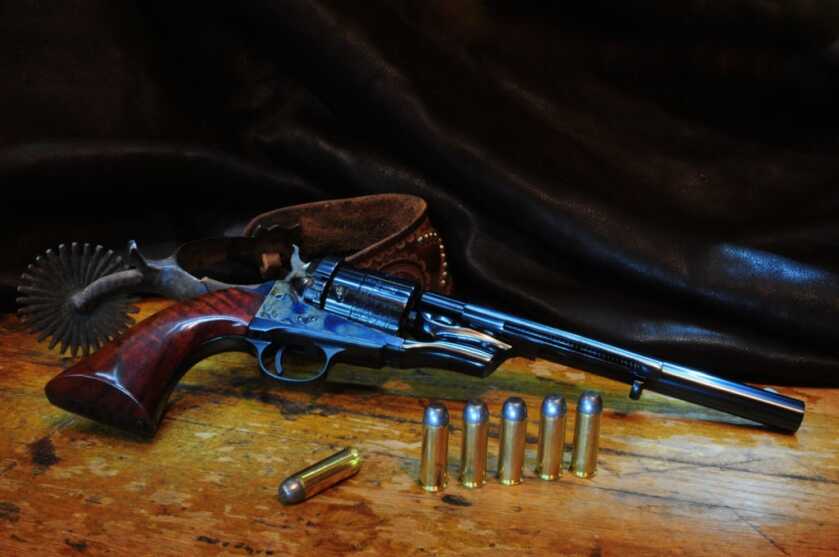 The war-torn years of the mid-19th century found the first really successful repeating handguns in the hands of fighting men across America. Beginning with Sam Colt’s Patterson model of 1836 (he designed and whittled a wooden prototype while aboard the ship Corvo in 1830) and ending with the Model 1860 Army and the 1861 Navy, American soldiers, cowboys, and criminals could now lay down sustained (sort of) fire during battle. As the saying goes, “God created all men: Sam Colt made them equal”.
The war-torn years of the mid-19th century found the first really successful repeating handguns in the hands of fighting men across America. Beginning with Sam Colt’s Patterson model of 1836 (he designed and whittled a wooden prototype while aboard the ship Corvo in 1830) and ending with the Model 1860 Army and the 1861 Navy, American soldiers, cowboys, and criminals could now lay down sustained (sort of) fire during battle. As the saying goes, “God created all men: Sam Colt made them equal”.
These early revolvers required the user to pour a measured charge of powder into each of the cylinders, follow it with a greased felt wad, and then ram a round or conical bullet home atop that. It was a tedious process, and the shooter still had to place a percussion cap on the nipple rearward of each chamber before he could fire. The cylinder could be removed quite rapidly, though, so some folks carried extra fully charged cylinders and swapped them out when in an upscuddle, much like magazines in modern handguns. However, they were messy, easily compromised by moisture, and could go to banging indiscriminately about, should they be dropped toward a hard surface and land on an exposed cap.
Still, though, those early revolvers were effective, cutting-edge weapons that saved (and took) many a life. Civil war soldiers on both sides relied on them heavily during the war, and many carried revolvers home afterward that had been either issued or picked up on the field of battle. The 1860 Army, in particular, was a masterfully designed weapon for its day, and many firearm experts and aficionados consider it the most beautiful handgun ever made. But its days were numbered; firearm design continued to advance rapidly, and in the late 1860s metallic cartridges – and the weapons that shot them – made a firm entrance onto the scene. (The US Army adopted the 44 Smith & Wesson “Schofield metallic cartridge firing revolver in 1870 as their service weapon.) This left the 1860 Army obsolete. Almost.
Enter the 1860 Richards Transition Model Conversion.
After the war there were many 1860s in use, as well as in process of manufacture. Notable design engineer and patent solicitor Charles Richards (who worked for Colt, and later helped design the legendary 1873 Colt Peacemaker) along with William Mason (another designer and inventor) engineered a conversion process. The cylinders were bored through, a breechplate was added, a loading gate was installed, and the loading lever was removed and replaced with an ejector rod. A firing pin was installed in the hammer face and Presto! The 1860 could now fire metallic cartridges – and was still the world’s most beautiful handgun.
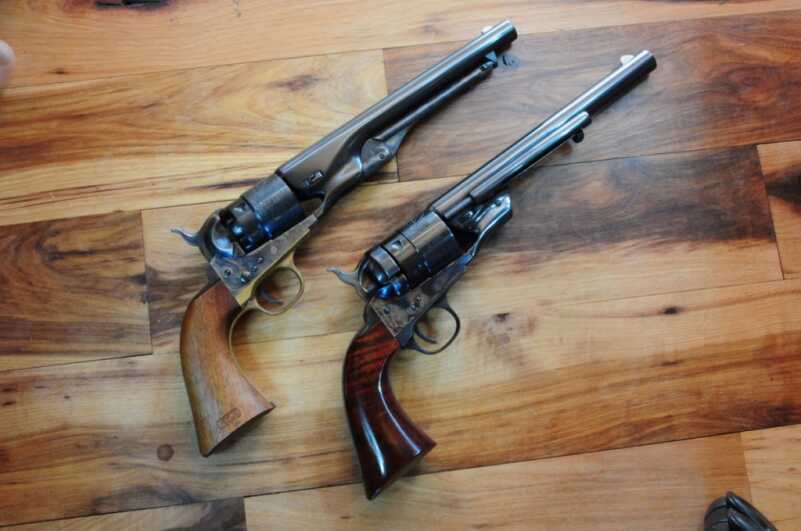
An 1860 Army and 1860 Conversion comparison, showing altered loading gate, breech plate, and ejector rod.
Original 1860 conversions were chambered in 44 Colt, but the contemporary “conversion” revolvers that caught my attention are chambered in readily available cartridges of today; 38 Special, 44 Special and 45 Long Colt, as well as a couple more obscure chamberings. Cimarron F.A.C. carries a noble assortment of conversion replicas made by Uberti. Various barrel length and chambering options are available, making a good selection of quality revolvers available to Cowboy Actions shooters, history buffs, and old west firearm enthusiasts.
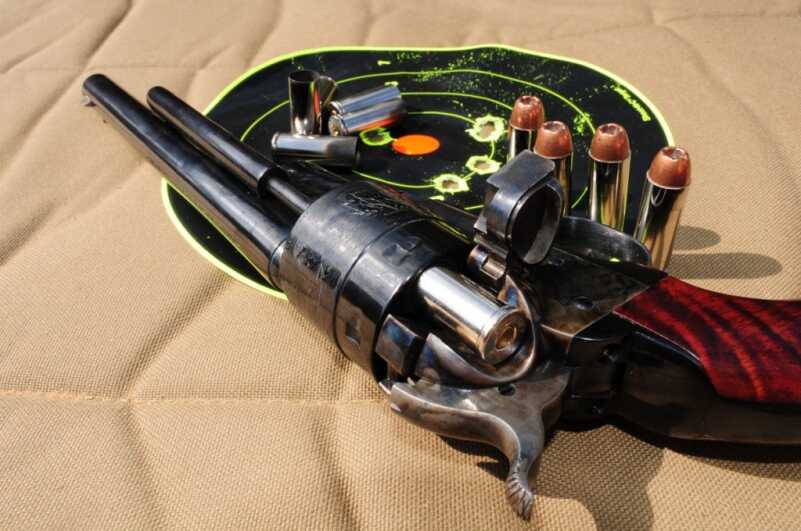
The Richards/Mason conversions enabled an 1860 to be loaded with cartridges, rather than powder and ball.
Opening a newly arrived box at my local FFL dealership inspired a couple “Wow!” responses – one of them my own. The 1860 Richards Transition Model Type II nestling therein sports eight glorious inches of gleaming blued steel barrel, a beautifully figured walnut grip, and a very nice color-casehardened frame. Fit is good, finish is good, the bluing is good, and though there are faint milling marks visible on the metal in areas, they are imperceptible enough that I didn’t notice them until I was sorting detail photos for this article. My first-ever handgun was a cap-&-ball 1860 Army revolver, and as I lifted this new conversion six-shooter out of its box I remembered how well they feel in the hand. Long and barrel heavy, but well balanced and graceful. And panache. Tons of panache.
The action on my 1860 Conversion is pleasantly tight and well tuned. Trigger break is very crisp at an average of three pounds seven ounces, as read by my Lyman trigger gauge. Cylinder-to-barrel gap is nice and tight, and I was pleased to note that even after firing several hundred test-rounds the gap was still tight, and the action was as well. Notably, the cylinder-to-barrel gap is adjustable via the barrel wedge. The barrel and cylinder can be removed for cleaning by turning the small wedge retaining screw just atop the wedge on the left side of the barrel. Orient the flat portion of the head with the wedge, remove the wedge and pull the barrel and cylinder off of the cylinder pin. To re-assemble, just reverse the procedure.
The revolver has no transfer-bar safety-type mechanism, so it is unsafe to keep a round in the chamber located just under the firing pin, as an accidental blow to the back of the hammer will detonate the cartridge beneath. Load the revolver in the traditional way; five rounds in the cylinder, and an empty chamber under the hammer. To load, simply swing open the loading gate, place the hammer on half-cock so the cylinder can rotate, and drop cartridges into the chambers. When you have five in lower the hammer over the empty chamber and you’re done.

The Richards/Mason conversions enabled an 1860 to be loaded with cartridges, rather than powder and ball.
Note: the Uberti 1860 Conversion has a small, screw-activated safety mortised into the inner curve of the hammer. When rotated into the safe position it blocks the hammer-fall from contacting the primer, making the pistol theoretically impossible to fire.
To eject empty cases after firing the shooter simply places the hammer back on half-cock, swings the loading gate open, and uses the ejector rod located at the right lower side of the barrel to push the spent cartridges free. I fired approximately 200 rounds over the course of a morning’s testing and experienced zero malfunctions.
Sights aboard the Richards Conversion are true to 1860 Army form: a small brass blade front sight, and a V-notch at the top edge of the hammer, not visible until the firearm is cocked.
Traditionally 1860s shoot rather high, and this six-gun was no exception. Each type of ammunition I tested impacted ten inches high at 25 yards. Accuracy was good, and all loads impacted in the same location.
As I write I keep reaching over and lifting the 1860 Army Richards Conversion, admiring the gleaming blued steel, hefting its pleasant balance, and cycling the action. I like it more every time. If you have any love of history, western lore, firearms, or cowboy attitude, you should check out the 1860 conversion. You won’t be disappointed.
Accuracy data was arrived at by firing three, 5-shot groups at 25 yards with each load. Groups were measured and then averaged. Velocity was arrived at by averaging the velocity of five rounds shot through a Shooting Chrony chronograph placed 10 feet in front of the shooter.
| Ammunition Manufacture | Bullet Weight (Grains) | Velocity (FPS) | Accuracy (Inches) |
| Hornady | 255 RNFP Cowboy | 740 | 2.2 |
| Hornady | 225 FTX | 829 | 3.3 |
| Black Hills Ammo | 250 RNFP | 777 | 2.7 |
| Winchester | 225 Bonded JHP Defender | 771 | 2.3 |
Learn more about Cimarron Firearms by clicking here.
***Shop GunsAmerica for your next Cimarron pistol***

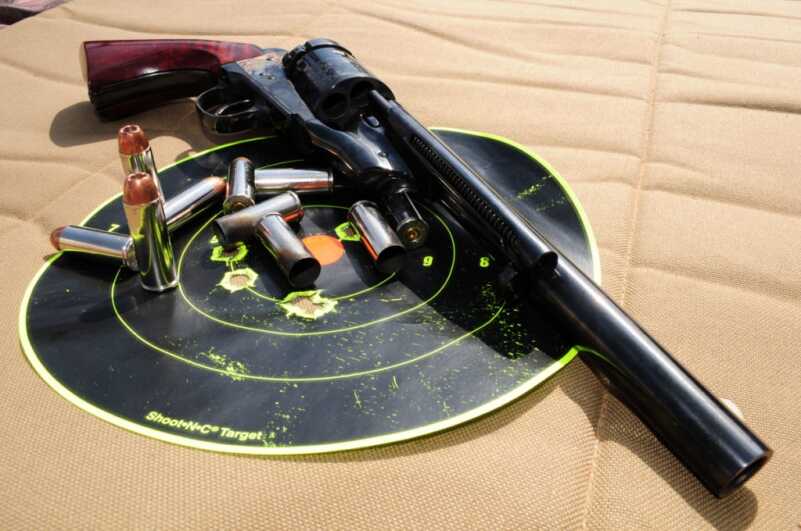
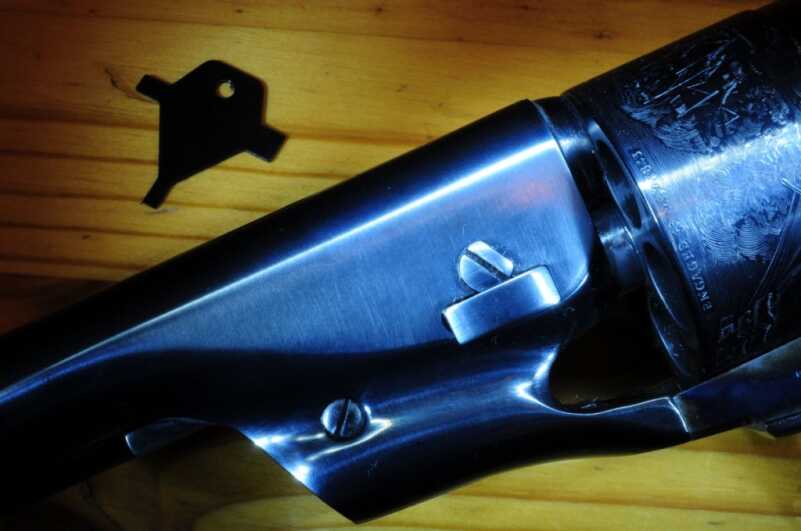
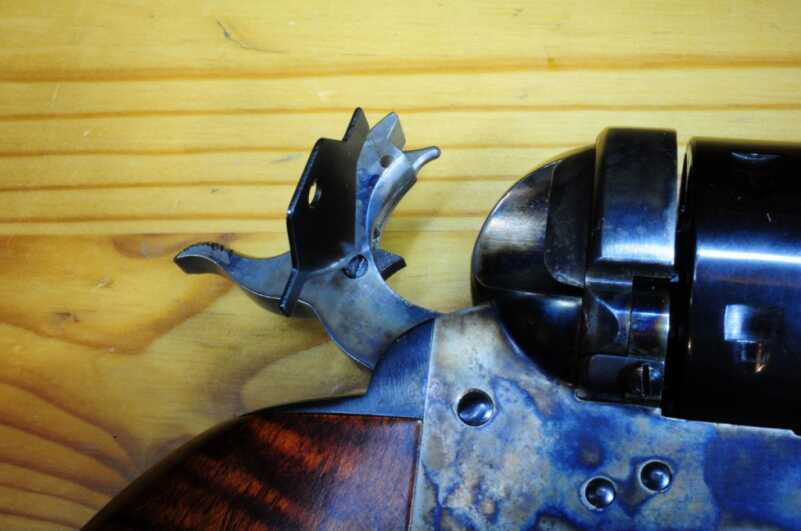
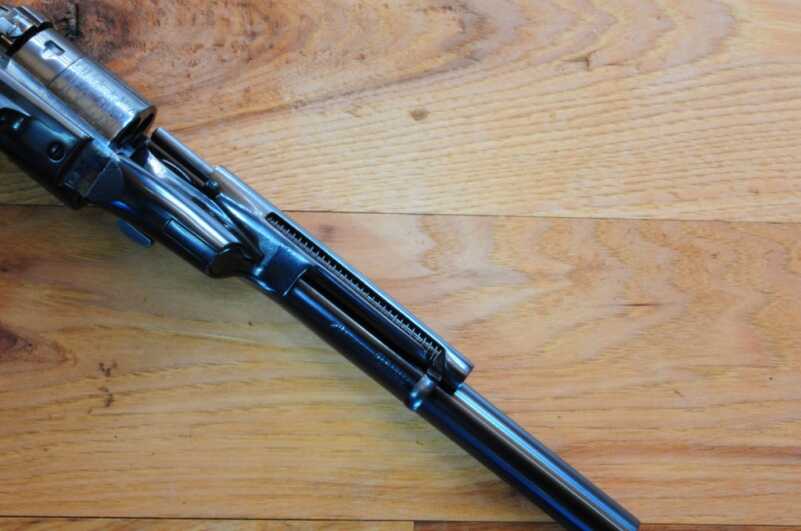
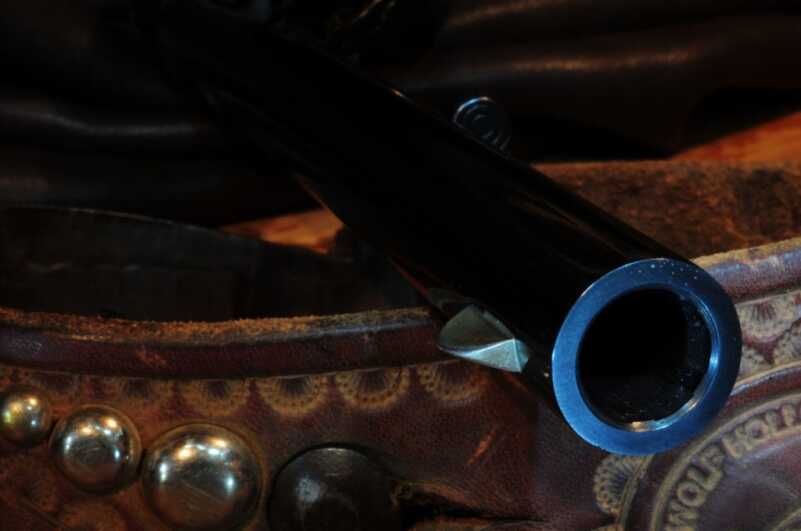
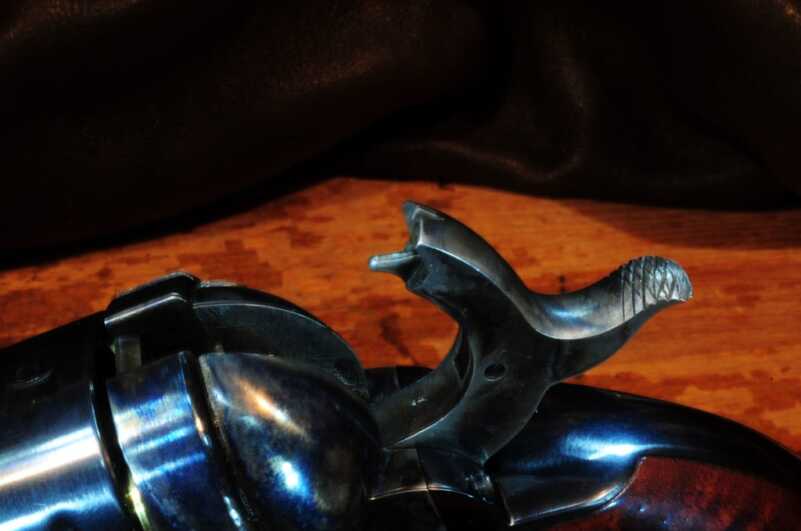

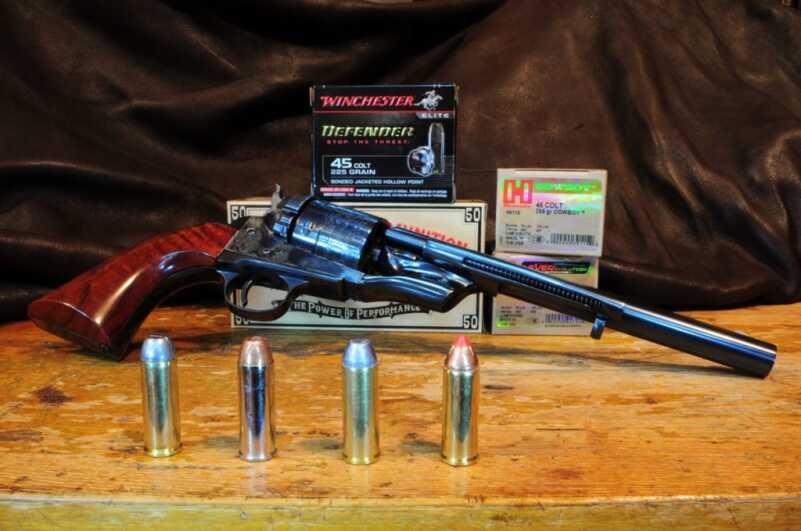
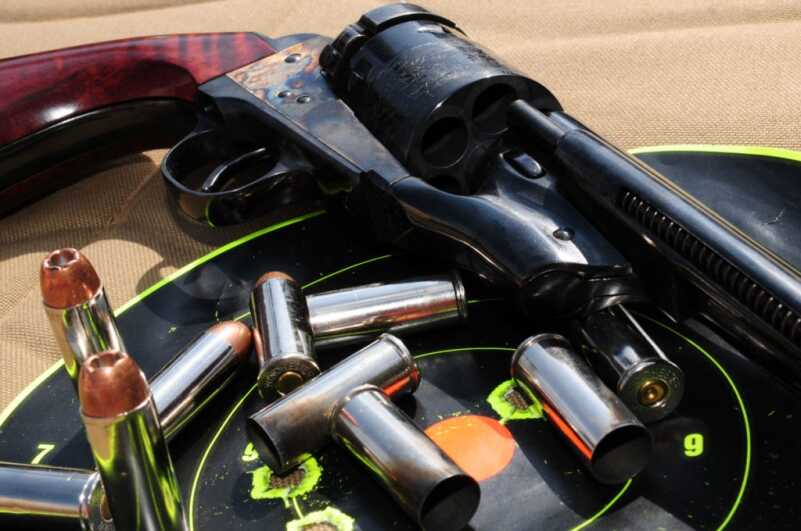
One of these in 38spl is on my top 5 range toy bucket list.
That is one bea-UT-iful gun! Makes the modern crap look like, well, crap!
Regrettably, that delight to behold is probably just another delight I won’t be able to afford to ‘behold.’ It stinks being a poor boy in a rich boy’s game! siiggghhhh
I think you can buy them from online discounters for around $500 – $600 which is not crazy high for any premium quality handgun. If that’s still too much for your wallet at one time, get a Pietta cap-&-ball .44 then later buy the .45 Colt conversion cylinder that Taylor’s makes.
That also makes for a very lovely .45 Colt piece though a little less convenient to load (you have to remove the cylinder to insert the cartridges).
The Cimarron pistol in this article is of exceptional quality ,
and very historically accurate . The .38spl. caliber shoots well ,
and is a delight in handling . As a big fan of this era in firearms ,
I am proud to include it in the collection .
Highly recommend this classic . One will not be disappointed !
I will echo Mike – those conversions should be loaded with lead, “cowboy” loads only which, although charged with modern, smokeless powder, mimic the chamber pressures of black powder loads. They are not intended for modern, jacketed bullets or modern-pressure loads.
Also, the 1860 Army was a cavalry pistol designed to engage an enemy across a wide field of battle, so the sights are regulated to 75 yards, which is why they print high at closer distances. But the long barrel and grip angle make them natural point shooters, so placing good shots by sighting over the top of the barrel is fairly easy at conversation distance.
Learned one thing here — checked my Cimarron 1851Colt Navy Richards Conversion (in .38 cal.) and discovered the same little screw safety in the hammer.
When reassembling the barrel I usually lightly tap the wedge with a small non-ferrous hammer before turning the wedge screw. Gives me a reassuring feeling whenever I fire it.
According to the manufacturer, you are NOT supposed to shoot jacketed bullets in that pistol. The reason is much higher chamber pressure of jacketed rounds compared to regular lead rounds.
Great review and photos. However please note that the city where Samuel Colt manufactured his first revolvers was Paterson, NJ and it was the Paterson Model of 1836, not Patterson…
Two minor points. I had always heard that the loading sequence to insure that the hammer fell on an empty cylinder was “load one, skip one, load four.” And according to my books, the 1862 Pocket Police is considered the most graceful cap and ball Colt model ever designed.
I have two 1851s, an 1860 Army, an 1861 Navy, and an 1862 Pocket Navy. The pocket Navy really is an elegant little pistol, but unfortunately my Uberti replica has never performed particularly well, certainly not as well as my others, all of which are Piettas. As to title of best looking of the bunch, I have always preferred the 1851 Navy. I still need to add a Richards-Mason conversion; I never knew they were produced in any caliber except .38. Of course, the one I would REALLY like to get my hands on is owned by a former client of mine, an original in .38 with original ivory grips, which I suspect set him back something north of $20,000.
I adore both of my open-top replicas a 38 Special and a 44 Special.